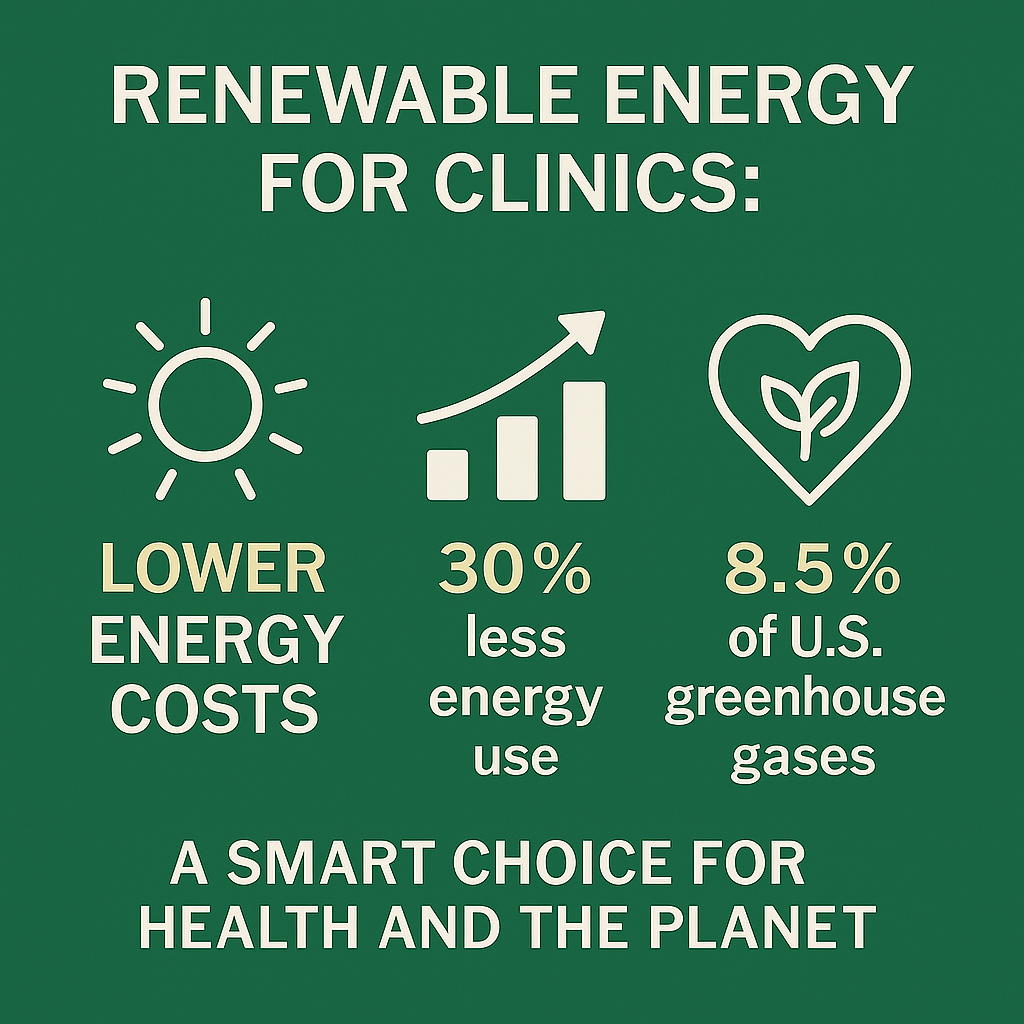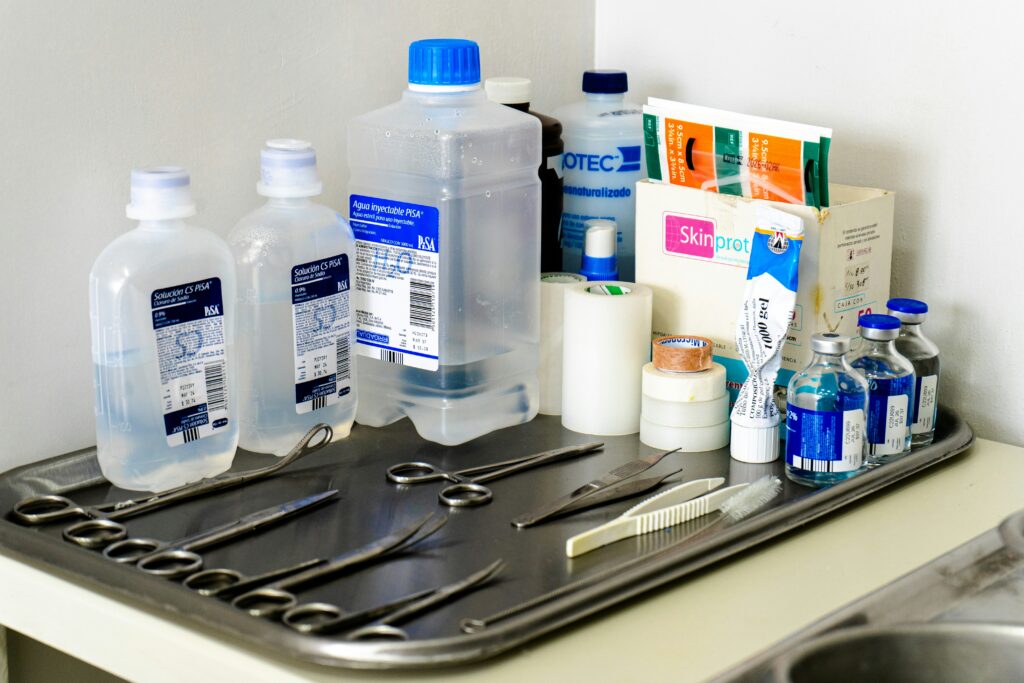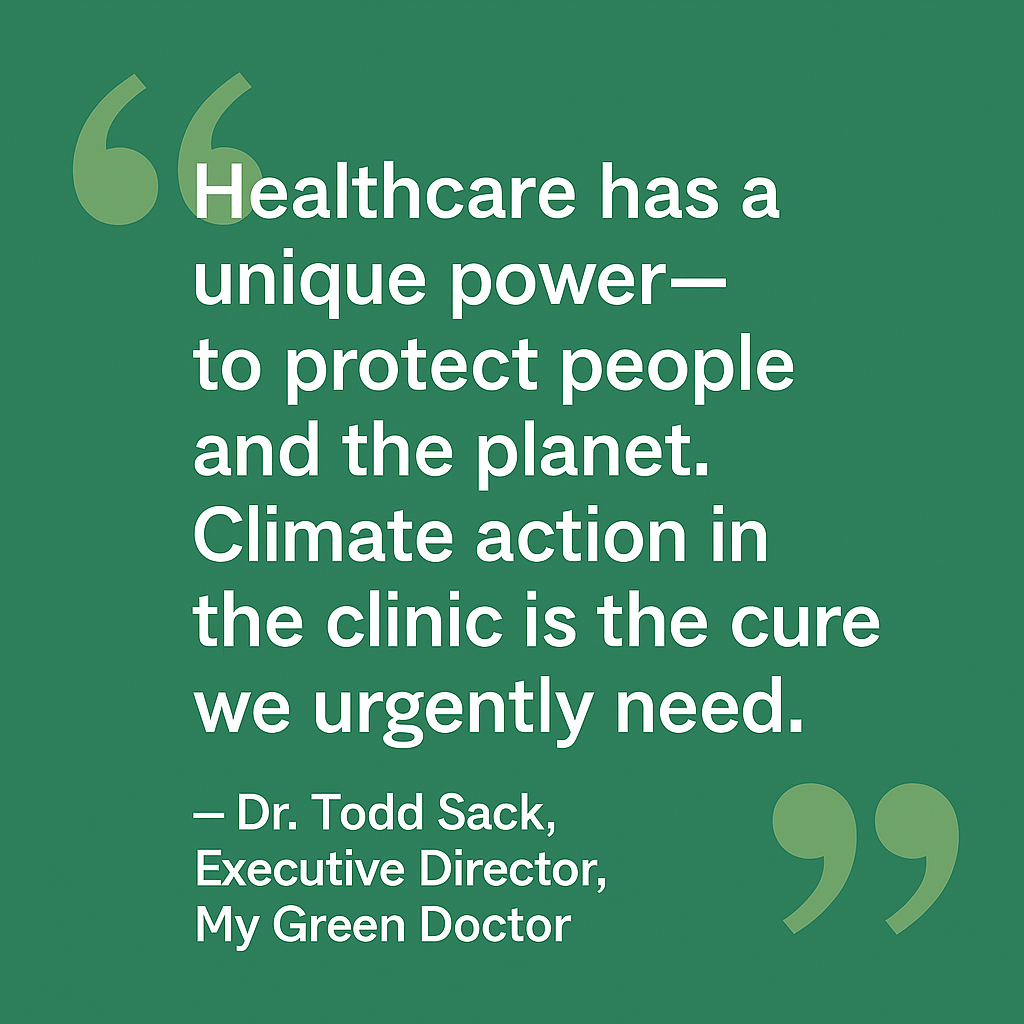

In This Issue:
- Why Renewable Energy Belongs in Every Clinic
- Medical Waste: One Model for Improvement
- OnTrack with your Sustainability Goals?

Powering Health, Protecting the Planet
– Why Renewable Energy Belongs in Every Clinic
Healthcare professionals have always been trusted voices on public health. Now, more than ever, they must also become champions of planetary health. One of the most impactful ways to lead this shift? Switching to renewable energy.
This isn’t just about saving the planet—it’s also about saving money, protecting patients, and strengthening our healthcare systems from the inside out.
The Business Case: Saving Big with Renewables
– Significant Cost Savings: Transitioning to renewable energy sources like solar power can lead to considerable reductions in energy expenses. For instance, the UK government’s initiative to install solar panels on National Health Service sites is projected to save each site up to £45,000 annually, amounting to approximately £13 million in total savings per year. Latest news & breaking headlines
And, in many countries, governments offer financial incentives to install solar panels and even backup batteries. Your electric company may offer the option to pay a bit more each month for your business to receive renewable electricity.
** Each of thes choices helps clean the air and is a credit towards qualifying for the MGD Green Recognition Certificate
– Long-Term Financial Stability: Renewable energy systems often come with fixed-rate power purchase agreements, shielding clinics from the volatility of fossil fuel prices. This financial predictability allows for better budgeting and resource allocation.
– Reduced Operational Costs: Implementing energy-efficient technologies, such as LED lighting and automated energy management systems, can decrease energy consumption by up to 30%, leading to further cost reductions. PMC
Environmental and Health Benefits
– Lower Carbon Emissions: The healthcare sector is responsible for approximately 8.5% of the United States’ greenhouse gas emissions. By switching to renewable energy, clinics can significantly reduce their carbon footprint, contributing to global efforts to combat climate change. Commonwealth Fund
– Improved Public Health: Renewable energy sources produce fewer air pollutants compared to fossil fuels. The U.S. Department of Energy estimates that cleaner air resulting from renewable energy adoption could save Americans up to $77 billion per year in health costs by reducing respiratory and cardiovascular diseases. The Department of Energy’s Energy.gov
– Enhanced Community Resilience: Clinics powered by renewable energy are better equipped to maintain operations during power outages, ensuring uninterrupted patient care during emergencies. For example, a California clinic installed a solar and battery storage system that can sustain operations for up to 15 hours without grid power, enhancing its resilience to natural disasters. AP News
At My Green Doctor, we believe environmental sustainability should be part of every healthcare conversation—and every clinic’s business plan.
That’s why our Practice Management program includes a guided, meeting-by-meeting path for helping clinics transition to renewable energy and cut utility bills—without overwhelming staff or adding to your to-do list.
Looking for a tailored approach? Our Consulting Services offer customized strategies for group practices, health systems, and medical societies ready to accelerate their impact and lead the way in climate-smart care.
A Healthier Future Starts with One Decision
Every healthcare office has the power to make a difference. Whether you’re just beginning your sustainability journey or ready to install solar panels, My Green Doctor is here to help you turn good intentions into real progress—for your budget, your patients, and the planet.
Visit our website to explore membership options, start a Practice Management program, or speak with us about our Consulting Services.
Let’s build a future where healthcare not only heals—it leads.
[email protected]

Author: Ishani Majmudar
Medical waste is rising tremendously each year, and its implications are not slight. Medical waste is a broad term used to describe any waste products generated at healthcare facilities and includes everything ranging from the disposal of small needles to the energy consumption of radiologic scans. Reducing waste can save money for practices and operating rooms, and benefit the environment.
The breadth of services provided by modern day medicine is profound. Innovative surgeries, novel pharmaceuticals, and state of the art technology are just a few of the driving forces that have aided the delivery of exceptional care to patients across all specialties. These advancements, however, come with a cost – both financial and environmental. During the COVID-19 pandemic, healthcare facilities gravitated towards disposable medical products to minimize the transmission of infection. A 2022 review paper reports that the total biomedical waste in the United States during the pandemic was upwards of 16,000 tons per day.1
Unfortunately, the use of disposables persists long after COVID-19 has abated. Excess medical waste exists within all specialties, though the degree of the problem varies. In my field of interest, ophthalmology, sources of unnecessary medical waste include single use eyedrops, oversized surgical drapes in the operating room, the unnecessary use of anesthetic gases during cataract surgeries, and single-use equipment. Organizations such as EyeSustain and My Green Doctor are educating clinicians and practice managers on ways to reduce medical waste and are promoting research on this topic.
My personal advocacy project is the problem of single use eyedrops. This example typifies our industry’s medical waste crisis and highlights some of the challenges we face and some has tangible solutions.
Dilating and anesthetic eye drops are routinely offered to patients in most ophthalmology clinics. The standard of care worldwide in clinics is to use multidose eyedrop bottles — meaning eyedrops from one bottle are administered to several patients. In the operating room, however, the practice has evolved to discard eyedrop bottles after just one use. The rationale for this practice is to minimize cross-contamination in a sterile environment, though there is scant research to support this contention.2
The arguments are solid for choosing multiuse eyedrops in operating rooms. A 2010 research study found that treating two patients per bottle instead of one would decrease plastic waste by approximately 12.69 tons in the United Kingdom each year.2 Beyond that, hundreds of thousands of dollars are being wasted each year due to unused pharmaceutical products; multiuse drops could save each large U.S. hospital upwards of $240,000 over 5 years.3
“Each U.S. hospital could save $240,000 per year.”
The Aravind Eye Care System is a network of sophisticated eye hospitals and clinics in India. A study at their Pondicherry hospital assessed the safety of using multidose drop bottles. Video recordings were taken as providers administered perioperative routine eyedrops to patients and the eyedrop bottle tips were cultured to assess microbial growth. The results of this study demonstrated that multidose eyedrops are a safe and plausible alternative to single dose eyedrop bottles. Additionally, the post-operative infection rates reported at Aravind were found to be lower than the rates in the United States, which employs a single-dose policy. 4
Changing to multiuse bottles will be challenging. Single use has become the custom for most clinicians and managers, and certainly has benefited the manufacturers handsomely. The use of medications in U.S. operating rooms is regulated by the individual states; changing to multi-dose eyedrops will require administrative and legislative advocacy by eye specialists in every state and country. In 2022, the American Academy of Ophthalmology created a legislative template for the “Topical Medical Waste Reduction Act” that would allow multiuse bottles for eye drop administration in ophthalmic surgery. This template is based on a 2021 Illinois law that allowed patients to take home any topically applied medications that were used during surgery if the patient needed it for postoperative care. Clinicians and medical professional societies can use this template to help implement much-needed change.
There are other steps that clinicians can in their practices and hospitals. First, begin asking questions and encouraging conversations about what you and your team can do to make your daily activities more environmentally sustainable. One way to begin is to ask your practice manager to take advantage of the free resources at EyeSustain and My Green Doctor.
Once you have begun adopting worked sustainable practices into your own clinic, consider working within your professional societies to work for change. The product manufacturers and vendors will need to be active partners as well. The unity of many voices and key stakeholders will be what creates lasting impacts!
Single-use eye drops in ophthalmology operating rooms is just one example of the waste crisis in healthcare. Concerned eye specialists have rolled up their sleeves to study the health, financial, and environmental implications, and have found creative medical and legislative solutions. Let this be your call to action!
References:
- Ngoc SV, Nguyen MA, Nguyen TL, Thi HV, Dao TL, Bui TMP, Hoang VT, Chu DT. COVID-19 and environmental health: A systematic analysis for the global burden of biomedical waste by this epidemic. Case Stud Chem Environ Eng. 2022 Dec;6:100245. doi: 10.1016/j.cscee.2022.100245. Epub 2022 Aug 10. PMID: 37520922; PMCID: PMC9364663.
- Somner, J., Cavanagh, D., Wong, K. et al. The precautionary principle: what is the risk of reusing disposable drops in routine ophthalmology consultations and what are the costs of reducing this risk to zero?. Eye 24, 361–363 (2010). https://doi.org/10.1038/eye.2009.129
- Berkowitz, S. T., Finn, A., Sternberg, P., Jr, & Patel, S. (2022). Potential Cost Savings Associated with a Multiuse Preoperative and Preinjection Eyedrop Protocol. Ophthalmology, 129(11), 1305–1312. https://doi.org/10.1016/j.ophtha.2022.06.023
- Wu, A. M., Kumar, P., Stein, J. D., Venkatesh, R., Zhou, Y., & Robin, A. L. (2021). A Videographic Evaluation of Eyedrop Administration by Ophthalmic Technicians. Ophthalmology, 128(5), 796–798. https://doi.org/10.1016/j.ophtha.2020.09.029
About the author
Ishani Majmudar is a Contributing Editor for My Green Doctor. She is a graduate of Northwestern University and is a rising 4th year medical student at the Feinberg School of Medicine at Northwestern University in Chicago. Her email address is [email protected].
Acknowledgement: Thank you to Dr. David J. Palmer, MD, for his support and leadership on this topic.

“Climate action in the clinic is the cure we urgently need.”
— Dr. Todd Sack, Executive Director, My Green Doctor
Are you on track with your sustainability goals?
Healthcare professionals are uniquely positioned to lead on climate—and their patients are listening.
From rising asthma rates to heat-related illnesses, climate change is already harming the most vulnerable among us. But there’s good news: every medical office can be part of the solution.
That’s where My Green Doctor comes in. We’re a nonprofit initiative that equips healthcare professionals, practice managers, and clinic administrators with the tools to make their operations more sustainable
My Green Doctor is a proven, science-based program that helps busy healthcare offices become more sustainable—while strengthening patient education and lowering operating costs.
This isn’t a one-time checklist or a vague green pledge. My Green Doctor offers a step-by-step, meeting-by-meeting process for guiding your team toward meaningful environmental improvements. It’s designed for the real world—where staff time is limited and budgets are tight.
Practices that use My Green Doctor report:
- Lower utility and supply bills
- Greater staff engagement
- New opportunities to educate patients about healthy, sustainable choices
- Certification that demonstrates leadership in climate-smart care
Whether you’re just starting or already implementing eco-friendly steps, this program helps you build momentum—and track your impact along the way.
It’s time to make environmental sustainability part of every healthcare conversation.
Explore membership options and enroll your office today, or speak with us about our bespoke consulting for your practice needs.
[email protected]

Share your sustainability progress with us!
Please let us know ! And, we encourage you to engage with friends and colleagues and help them accelerate their sustainability journey.
[email protected]



